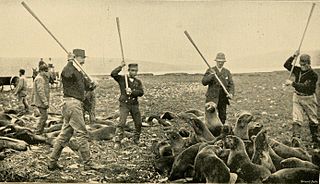
Aprilov Point is a point on the north coast of Greenwich Island, Antarctica situated 6.9 km east of Duff Point, 2.1 km east-southeast of Kabile Island, 2.2 km east-northeast of Crutch Peaks, 1.8 km south of Ongley Island, 5.5 km west of Agüedo Point, and 2.3 km north-northwest of Sevtopolis Peak. Forming the east side of the entrance to Haskovo Cove and the west side of the entrance to Skaptopara Cove.

Smirnenski Point is a narrow, ice-free point on the east coast of Robert Island projecting 1.1 km into Nelson Strait in the South Shetland Islands, Antarctica, and forming the northwest side of the entrance to Garnya Cove.

Herring Point is a point on the north coast of Rugged Island off the west coast of Byers Peninsula of Livingston Island in the South Shetland Islands, Antarctica forming the east side of the entrance to Hersilia Cove.

Santa Cruz Point, also Spencer Bluff, is a rocky point forming the east extremity of Greenwich Island in the South Shetland Islands, Antarctica and the southwest side of the entrance to English Strait. Surmounted by Bogdan Ridge on the west.

Edwards Point is a rocky point in the south extremity of Kermen Peninsula and Robert Island in the South Shetland Islands, Antarctica. The point is a southeast entrance point of English Strait and forms the west side of the entrance to Devesil Bight and the southeast side of the entrance to Micalvi Cove. The area was visited by early 19th century sealers.

Negra Point is the ice-free tipped point on the southwest coast of Robert Island in the South Shetland Islands, Antarctica forming the southeast side of the entrance to Mitchell Cove. The area was visited by early 19th century sealers.

Fort William Point is the conspicuous flat-topped rocky headland forming the northwest extremity of Coppermine Peninsula and Robert Island in the South Shetland Islands, Antarctica. The point is a northwest entrance point of English Strait and forms the west side of the entrance to Carlota Cove.

Triangle Point is the low ice-free tipped point forming the northwest side of the entrance to Shopski Cove in the south coast of Parvomay Neck linking the northwest and southeast parts of Greenwich Island in the South Shetland Islands, Antarctica. The area was frequented by early 19th century sealers operating from Yankee Harbour.

Spark Point, also Canto Point, is a rocky point forming the northwest side of the entrance to both Discovery Bay and Galápagos Cove, and the east side of the entrance to Jambelí Cove in the northeast of Greenwich Island in the South Shetland Islands, Antarctica. The point ends up in a conspicuous monolithic formation and has an adjacent ice-free area of 164 hectares. The area was visited by early 19th century sealers.

Ash Point is a rounded low ice-free point forming the southeast side of the entrance to Discovery Bay in the northeast of Greenwich Island in the South Shetland Islands, Antarctica with an adjacent ice-free area of 201 hectares. Letelier Bank is lying off Ash Point, while Bascopé Point is situated 460 m (503 yd)to the southwest, with the 1 km (0.62 mi) wide Rojas Cove indenting for 310 m (339 yd) the coast between that point and Guesalaga Peninsula. The area was visited by early 19th century sealers.

Hammer Point is a rocky point projecting from the north coast of Robert Island in the South Shetland Islands, Antarctica 1 km north-northwestwards into Drake Passage, and forming the southwest side of the entrance to Nevestino Cove and the northeast side of the entrance to Clothier Harbour. The area was visited by early 19th century sealers operating from Clothier Harbour.

Ferrer Point is a point projecting 700 m into the south part of Discovery Bay, Greenwich Island in the South Shetland Islands, Antarctica with an adjacent ice-free area of 24 hectares. The point forms the west side of the entrance to Montecinos Cove and the northeast side of the entrance to Rodríguez Cove.

Labbé Point is a point projecting 600 m (660 yd) into the southwest part of Discovery Bay from Parvomay Neck, Greenwich Island in the South Shetland Islands, Antarctica with an adjacent ice-free area of 11 hectares. The point forms the northwest side of the entrance to Basullo Cove and the east side of the entrance to Vinett Cove. The small Basso Island is linked by a mainly submerged spit to the north side of Labbé Point.

Agüedo Point is the point forming the north extremity of Greenwich Island in the South Shetland Islands, Antarctica and the west side of the entrance to Guayaquil Bay. The adjacent ice-free area of Flamingo Beach on the west covers 80 hectares, and ends in Terimer Point, the east entrance point of Skaptopara Cove.

Guesalaga Peninsula is a small, L-shaped, low-lying shingle covered peninsula on the east side of Discovery Bay, Greenwich Island in the South Shetland Islands, Antarctica forming the northwest coast of Iquique Cove and the north side of its entrance. The feature is projecting 700 m (766 yd) southwestwards and 300 m (328 yd) wide, with the narrow shingle Reyes Spit extending 400 m (437 yd) southwestwards from its west extremity Reyes Point into Discovery Bay. The Chilean Antarctic base Arturo Prat is situated on the peninsula.

Sotos Point is a glaciated point projecting 180 m into the southeast part of Discovery Bay, Greenwich Island in the South Shetland Islands, Antarctica and forming the east side of the entrance to Montecinos Cove.

Misnomer Point is the ice-free tipped point projecting 400 m westwards from the northwest coast of Alfatar Peninsula, Robert Island in the South Shetland Islands, Antarctica and forming the east side of the entrance to Carlota Cove. The area was visited by early 19th century sealers operating from Clothier Harbour.










